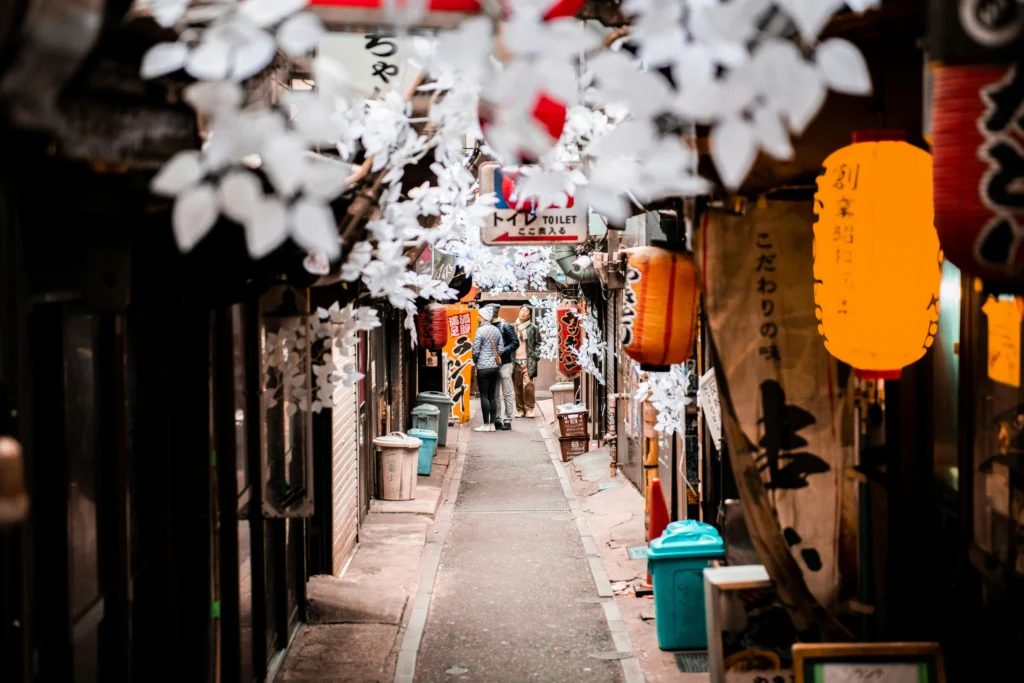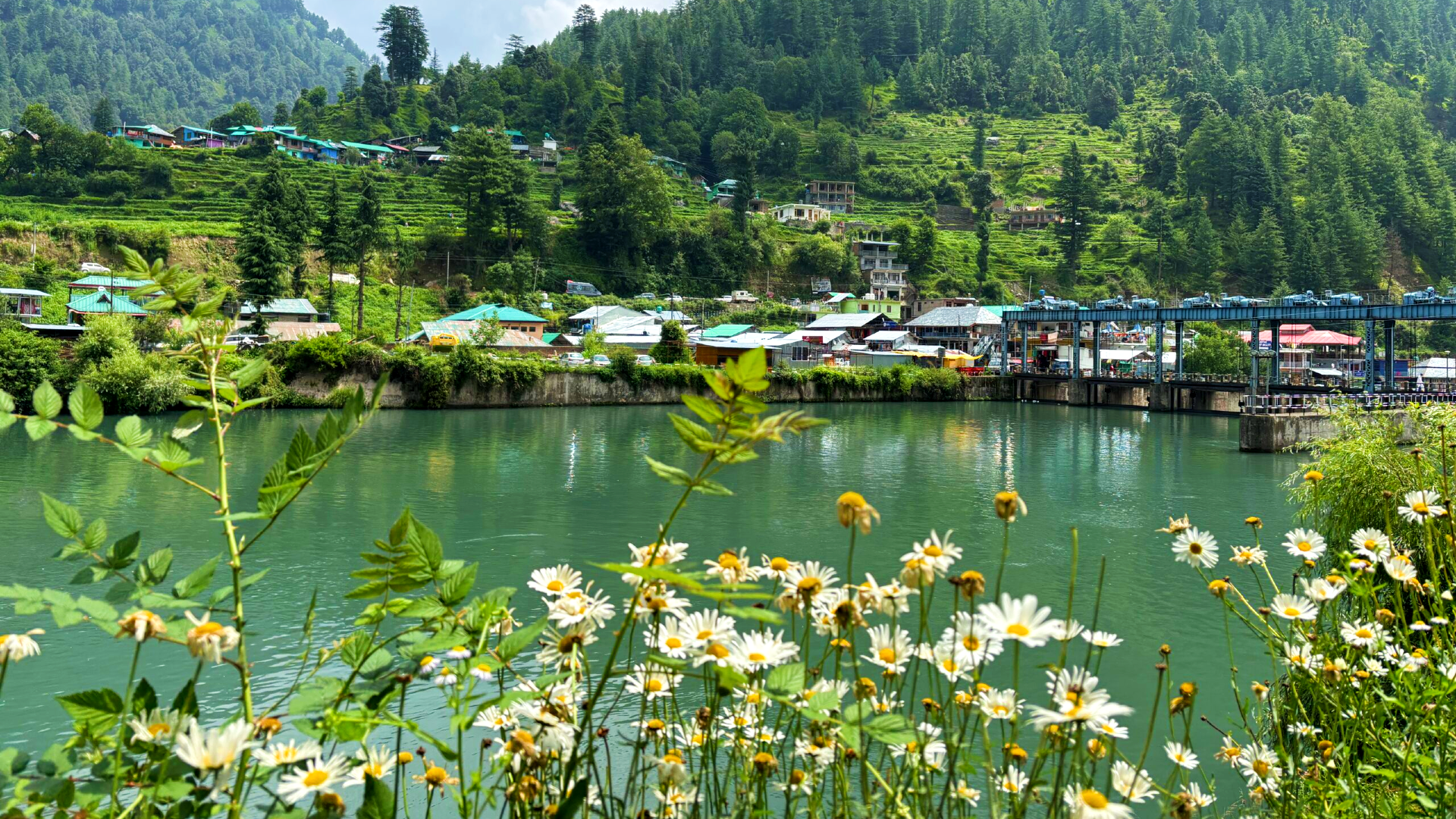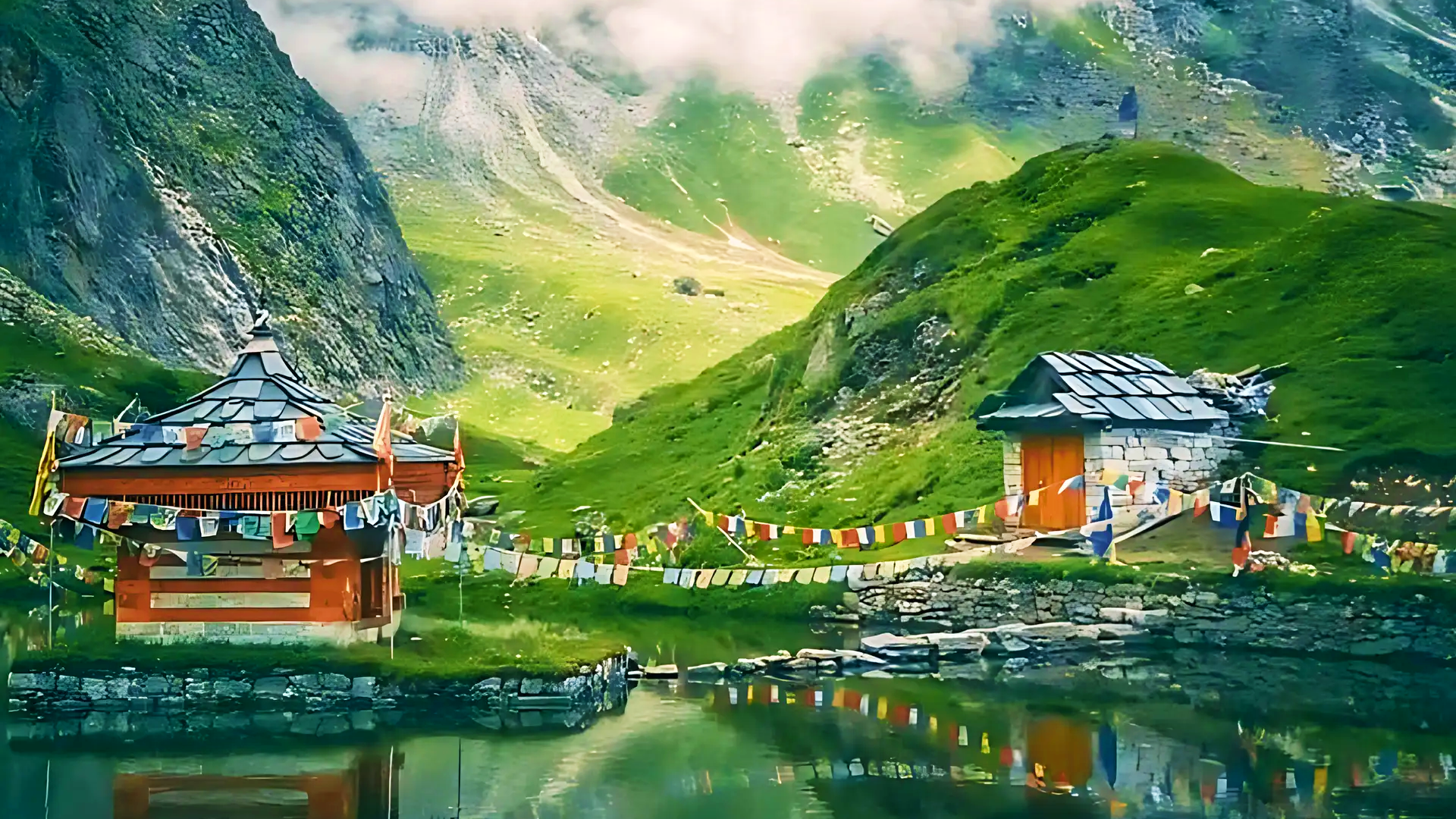Planning your first solo visit to Japan? You’ve just discovered the ultimate 5 day Tokyo guide. Whether you like neon city streets, historic temples, kooky cafes, or peaceful parks, we have include everything in this 5 day Tokyo itinerary so that you can plan your time throughout this incredible city, giving you the very best experiences.
This 5-day Tokyo itinerary is designed for solo travelers to experience the best of Japan’s cosmopolitan capital in the shortest possible time. From iconic neighborhoods and cultural attractions to budget advice and offbeat suggestions, this itinerary will enable you to see Tokyo like a local — with the right blend of adventure, cuisine, and serene moments.
So pack light, charge your camera, and get ready for an unforgettable Tokyo journey — solo doesn’t mean alone when you’re in one of the world’s most exciting cities.
Table of Contents
Tokyo Travel Tips for Solo Travelers

1. Learn Basic Japanese Phrases
Tokyo is a foreigner-friendly city, but knowing a few basic Japanese phrases can greatly enhance your experience. While many people in tourist areas speak some English, interactions in smaller shops, restaurants, and residential neighborhoods may require basic Japanese. Simple words like “Sumimasen” (excuse me), “Arigatou gozaimasu” (thank you), and “Eigo o hanasemasu ka?” (Do you speak English?) can help you navigate daily interactions. Learning polite greetings such as “Konnichiwa” (hello) and “Onegaishimasu” (please) can also go a long way in making a positive impression.
2. Get a Suica or Pasmo Card
Tokyo’s public transportation system is one of the most efficient in the world, but it can be overwhelming for first-time visitors. A prepaid Suica or Pasmo card simplifies your travel by allowing seamless, tap-and-go access to trains, buses, and even some taxis, vending machines, and convenience stores. These cards can be purchased and reloaded at train stations, eliminating the need to buy individual tickets for each trip. The convenience of a Suica or Pasmo card will save you time and make your travels stress-free.
3. Stay in Capsule Hotels or Hostels
Solo travellers looking for budget-friendly accommodations have plenty of options in Tokyo. Capsule hotels provide a uniquely Japanese experience, offering compact sleeping pods with privacy and modern amenities. If you prefer a more social environment, hostels are a great way to meet fellow travellers. Many hostels in Tokyo provide communal spaces, events, and cultural experiences. Both options allow solo travellers to stay comfortably and affordably while immersing themselves in the city’s atmosphere.
4. Use Google Maps & Hyperdia
Navigating Tokyo’s complex transportation network is made easier with technology. Google Maps provides real-time directions, estimated travel times, and station exits, while Hyperdia is especially useful for detailed train schedules, including bullet train routes. These apps help solo travellers efficiently plan their journeys and avoid unnecessary confusion. Since Tokyo has multiple railway companies operating different lines, these tools are invaluable for seamless navigation.
5. Carry Cash & a Credit Card
While Tokyo is a modern metropolis, cash is still widely used, especially in small eateries, local markets, and some older establishments. Many restaurants and temples only accept cash, so it’s important to have some yen on hand. However, major department stores, hotels, and chain restaurants accept credit cards. ATMs at 7-Eleven convenience stores are the most reliable for foreign cards, making it easy to withdraw cash when needed.
6. Take Advantage of Convenience Stores
Japanese convenience stores, known as konbini, are a solo traveler’s best friend. Stores like 7-Eleven, FamilyMart, and Lawson offer high-quality, affordable meals ranging from sushi and bento boxes to fresh sandwiches and hot coffee. They also stock travel essentials, toiletries, and even ATMs. Many stores operate 24/7, making them a lifesaver for late-night snacks or quick breakfasts before heading out.
7. Travel Light & Wear Comfortable Shoes
Tokyo is a city best explored on foot, with many attractions, shopping streets, and cultural sites requiring significant walking. Comfortable walking shoes are a must to navigate train stations, busy streets, and parks. Packing light also makes it easier to move through crowded trains and small accommodations, reducing the hassle of carrying heavy luggage.
8. Be Mindful of Etiquette
Japanese culture places great emphasis on manners and etiquette. When using escalators, stand on the left and walk on the right (except in Osaka, where it’s reversed). Speaking loudly on trains is considered rude, and answering phone calls should be avoided. Bowing is a common way to show respect, and it’s customary to remove shoes before entering someone’s home or traditional accommodations. Being aware of these customs will help you blend in and show respect to locals.
How to Travel Around Tokyo

Use the Train & Subway System
Tokyo’s subway and train system is one of the most efficient, on-time, and well-linked public transport systems in the world. The JR Yamanote Line is especially convenient for visitors as it loops around inner Tokyo and links major districts such as Shibuya, Shinjuku, Ueno, and Tokyo Station. Other lines that are a must-ride include the Tokyo Metro and Toei Subway, which link all the major sights and neighborhoods. For visitors, the JR Pass (for travel throughout the country) or the Tokyo Subway Ticket (for unlimited subway travel) can be economical choices.
Rent a Bike in Specific Locations
Even though Tokyo is a congested city, there are certain locations such as Asakusa, Yanaka, and Kichijoji that are less congested with peaceful roads where a person can bike easily. All the rental shops have bikes available for rent at affordable rates, and some even have electric bikes for easy travel. Biking is a peaceful mode of visiting temples, parks, and off-the-beaten-path locations that might be more difficult to reach via the train.
Walk When You Can
Walking is probably the best means of absorbing the street life of Tokyo. Areas like Harajuku’s Takeshita Street, Ginza’s upscale shopping district, and Asakusa’s ancient alleys offer varying perspectives best appreciated on foot. Wandering through residential areas can lead to the discovery of tiny shrines, charming cafes, and old-fashioned markets easily missed by those who only move by public transport.
Take Taxi or Ride-Sharing Every Now and Then
Although Tokyo’s taxis are clean, safe, and readily available, they are extremely expensive compared to public transportation. The starting fare is approximately 500-700 yen for the initial kilometer, and traveling more costs additional. Ride-sharing like Uber is an option but isn’t used as often since there are strict restrictions. However, for a late night when the trains stop running around midnight, the taxi is a godsend.
Make the Most of IC Cards
IC cards like Suica and Pasmo are a blessing when traveling within Tokyo. They are rechargeable and can be used on all trains, subways, and buses, without the need to buy single tickets each time. They can even be used to buy things at vending machines, convenience stores, and some restaurants, and are an absolute must for tourists.
Where to Stay in Tokyo (Budget Options)

Capsule Hotels
The capsule hotel market delivers a particular low-cost way to experience accommodation. People who seek cheap and convenient accommodations will adore these compact bed pods designed especially for single travelers.
Located in Shinjuku’s nightlife and shopping zones Nine Hours Shinjuku-North provides visitors with a contemporary and tidy capsule hotel experience.
Located in the well-known electronics district of Akihabara stands First Cabin Akihabara as a spacious luxury capsule hotel.
Hostels
People who want to meet others on their budget travels will find hostels an excellent choice for accommodation. Many hostels in Tokyo offer dormitory-style beds as well as private rooms.
UNPLAN Shinjuku stands as a fashionable hostel which provides communal living accommodations together with private guestrooms right in Shinjuku’s central district.
Toco Tokyo Heritage Hostel – A charming traditional Japanese-style hostel with a peaceful atmosphere in a historic building.
Budget Hotels
Budget hotels provide solo travelers privacy at reasonable prices through their straight-forward and comfortable small accommodations.
Sakura Hotel Jimbocho maintains a friendly budget-friendly hotel reputation among its international host to guest community.
Hotel Mystays Asakusa features basic clean rooms in a vicinity near Asakusa historic sites.
Business Hotels
Catering to the needs of business travelers business hotels present reasonable-priced small but practical accommodation spaces.
The budget-friendly Toyoko Inn Tokyo Shinjuku Kabukicho business hotel provides guests free breakfast in its lively neighborhood.
APA Hotel Shibuya Dogenzaka sits perfectly close to Shibuya Crossing with its comfortable accommodations combined with modern hotel features.
Ryokan (Traditional Inns) on a Budget
Traditional Japanese guests appreciate ryokan accommodations because they provide rooms made from tatami mats and futon bedding.
Ryokan Asakusa Shigetsu serves visitors with traditional services while remaining budget-friendly in the area near Sensō-ji Temple.
Homeikan stands as a historic ryokan which offers traditional Japanese accommodation around Tokyo University in a peaceful location.
How many days should I spend in Tokyo?
If you’re wondering how long to stay in Tokyo, I’d say go for at least 5 days — trust me, this city is way bigger than you think.
On my first solo trip to Japan, I planned a 7-day adventure. The idea was to spend a few days in Tokyo and then squeeze in a couple of day trips. But once I arrived, I quickly realized how massive and packed Tokyo really is. Every neighborhood felt like a mini city of its own, each with something totally different to explore.
In the end, I spent 5 full days in Tokyo and barely managed to take a short trip to Hakone. Even then, I felt like I was only scratching the surface. There was still so much left to see and do — which is exactly why I ended up returning a few more times. And honestly? Every visit shows me a whole new side of Tokyo I hadn’t seen before.
That’s why we created this 5-day Tokyo itinerary here at Lone Travellers — it’s based on real experiences, and it’s perfect for solo adventurers like you who want to soak in the best of the city without feeling rushed.
The 5 Day Tokyo Itinerary
Tokyo is huge. Like… really huge. As a solo traveler, it’s easy to get overwhelmed by how much there is to see and do. That’s why it helps to plan smart — group nearby spots together so you’re not wasting time zigzagging across the city.
When I put this Tokyo itinerary together for Lone Travellers, I focused on making your days more efficient and enjoyable. Each day covers one area or neighborhood, so you can explore at your own pace without feeling rushed. You’ll hit the big landmarks, soak in the vibes of different districts, and maybe even stumble across a few unexpected gems along the way.
And here’s the best part: you don’t need to follow this plan in order. Mix and match the days however you like based on your energy, mood, or even the weather. And hey — if you don’t get to everything, that just means you have a reason to come back to Tokyo (like I did… more than once 😉).
Here’s a quick peek at the itinerary:
Day 1: Yoyogi Park, Harajuku, Omotesando & Roppongi
Day 2: Shibuya + hidden corners nearby
Day 3: Akihabara, Ueno Park & Asakusa
Day 4: Shinjuku and all its buzzing chaos
Day 5: Tuna Auction, Ginza, Imperial Palace & nearby shrines
Extra Ideas: Want even more things to do in Tokyo? I’ve got you covered.
To make things easy, I’ve also added a Google Maps link that shows all the routes and stops mentioned in this itinerary. Perfect for navigating the city like a pro ✌️
Download this map.
And FINALLY here is a detailed list of what to do in Tokyo on your solo trip:
Day 1: Yoyogi Park, Harajuku, Omotesando & Roppongi — A Relaxed Beginning in Tokyo
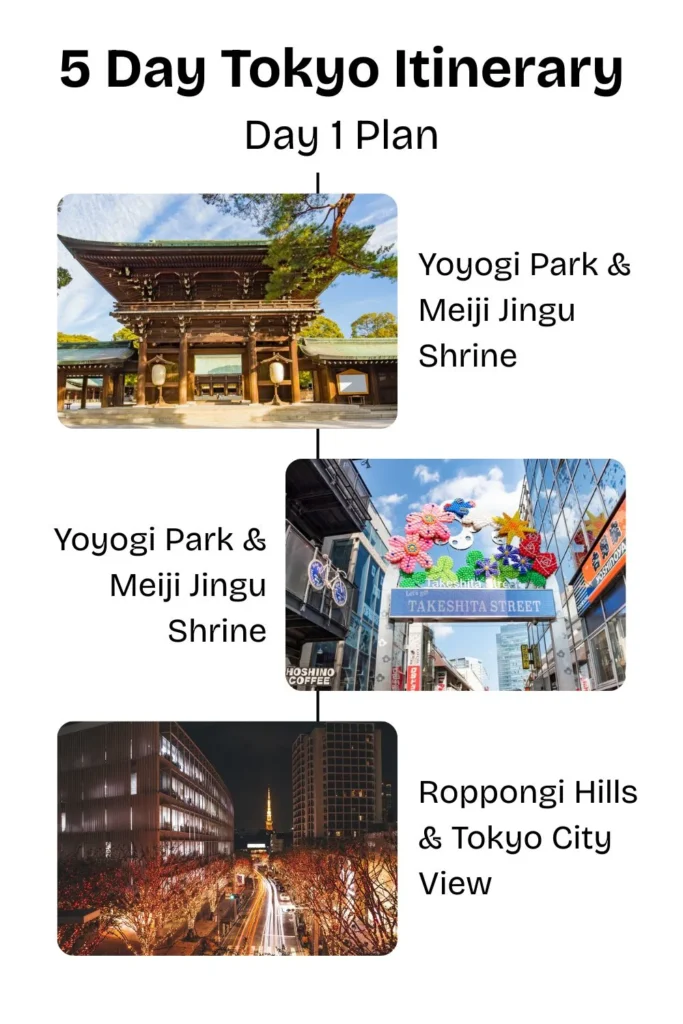
Here’s how to kick off your adventure in Tokyo in the most harmonious mix of nature, culture, querky fashion and magnificent views. Walking alone or equipped with camera gear, this tour is most suited for solo travelers who yearn for a little bit of it all of Tokyo.
1. Morning: Yoyogi Park & Meiji Jingu Shrine
Begin your day with a serene stroll through Yoyogi Park — one of Tokyo’s largest green areas. It’s tranquil, soothing, and the best way to get acclimated to the city.
Situated right in the center of the park is the stunning Shinto shrine of Meiji Jingu Shrine, surrounded by lush tall trees. It’s not to be missed for its peaceful vibes, and a perfect place to buy an amulet or write down a wish on a wooden board.
2. Late Morning: Harajuku & Takeshita Street
From the park, just cross the street and you’re in the heart of Harajuku. This place is loud, colorful, and full of life. Walk down Takeshita Dori, a narrow street packed with trendy shops, snacks, and people dressed in wild fashion.
Keep your eyes open — you might spot some bold fashionistas on the weekend! Drop by Laforet Mall for more eccentric styles and explore all the cute food stalls.
Things You Should Try:
Japanese crepes – sweet, loaded with fruits & syrup
Eiswelt Gelato – adorable animal-shaped ice cream
I’m Donut? – viral mochi-style donuts (go early to skip the line!)
3. Afternoon: Omotesando, Aoyama & Design Stops
Keep walking east and you’ll hit Omotesando, Tokyo’s version of Champs-Élysées. It’s stylish, clean, and lined with designer stores and beautiful architecture.
Wander through:
Tokyu Plaza – take a mirror selfie at the iconic entrance
MoMA Design Store – cool design finds from around the world
Nezu Museum – if you’re into art and hidden gardens
This whole stretch is super walkable and perfect for casual browsing, even if you’re not into shopping.
4. Evening: Roppongi Hills & Tokyo City View
End your day with an epic view. Head to Roppongi Hills and take the elevator up to the Tokyo City View Observation Deck. For just ¥1,800, you’ll get one of the best panoramic views of Tokyo — including Tokyo Tower and, if you’re lucky, Mount Fuji.
Tip: Arrive close to sunset and stick around — Tokyo by night is pure magic.
Bonus: Check out the Mori Art Museum (same building, ticket combo available)
Tokyo Midtown nearby is also worth a look, especially for souvenir shopping and beautiful interior design.
Where to Eat on Day 1

Japanese Crepes (Harajuku) – Grab one while you stroll down Takeshita Dori
Eiswelt Gelato (Harajuku) – Only open on weekends, but super cute!
Maisen Tonkatsu (Omotesando) – Famous for juicy black pork cutlets
Sincere Garden (Omotesando) – A chill organic cafe for vegetarians
Tempuraya Miyagawa (Aoyama) – Cozy spot for a tempura lunch set
Tokyo Whisky Library (Roppongi) – Huge collection of Japanese whisky
Day 2: Exploring Shibuya & Nearby Neighborhoods – A Day of Iconic Crossings, Hidden Cafes & Nightlife

Welcome to one of Tokyo’s most energetic neighborhoods — Shibuya. If you’ve seen photos of that famous street where hundreds of people cross in every direction without bumping into each other… yep, that’s Shibuya Scramble. But beyond the chaos, this part of Tokyo is full of surprises — cozy alleyways, trendy cafés, wild nightlife, and some of the city’s coolest neighborhoods like Ebisu, Nakameguro, Daikanyama, and Shimokitazawa.
Let’s break down the perfect way to spend your Day 2 in Tokyo with Lone Travellers.
1. Morning: Experience the Shibuya Scramble Crossing
Start your day at Tokyo’s busiest intersection (might be world’s busiest intersection). Just outside Shibuya Station, Shibuya Scramble Crossing is where hundreds of people cross from all directions at once — yet somehow, no one crashes into each other.
Tip: Skip the crowded Starbucks view. Stand on street level and soak in the magic. It’s chaotic, but somehow calming at the same time.
2. Late Morning: Say Hello to Hachiko
Right near the crossing, visit the Hachiko Statue — a tribute to Japan’s most loyal dog. Hachiko waited outside this very station for years, hoping his owner would return. It’s more than a photo spot — it’s a touching story that locals truly admire.
3. Afternoon: Catch the Views from Shibuya Sky
For one of the best views in Tokyo, head to Shibuya Sky. This open-air rooftop lets you see Tokyo’s skyline stretch all the way to Mt. Fuji on a clear day. Go just before sunset for golden hour shots and stick around to see the city light up at night.
4. Evening: Shop ‘til You Drop
Shibuya is a shopper’s paradise. Pop into:
Shibuya Loft – For quirky Japanese gifts and home finds.
Don Quijote (Donki) – A wild maze of everything from snacks to souvenirs.
Shibuya Hikarie – A classier mall with Japanese fashion brands.
5. Night: Explore Dogenzaka After Dark
When the sun sets, wander over to Dogenzaka. Once known for its shady past, it’s now full of cozy ramen joints, izakayas (small bars), and… a few love hotels too. Don’t worry, it’s safe and buzzing with energy. Great for solo travelers who love exploring nightlife.
Where to Eat Around Shibuya

Here are some Lone Travellers-approved spots for good eats nearby:
Ichiran Ramen – Famous tonkotsu ramen in private booths. Order from a vending machine!
Katsukichi – If you love pork, try their crispy tonkatsu in a cozy setting.
Tokyu Foodshow – Underground food market packed with sushi, bento, sweets, and snacks.
Kushiyaki Bistro Fukumimi (Dogenzaka) – Chill izakaya for grilled skewers and drinks.
Gyukatsu Motomura – Deep-fried beef you cook yourself on a hot stone. Expect a wait!
Hidden Gems in Nearby Neighborhoods
If you have more time (or want a slower-paced afternoon), hop on a train and check out these charming spots:
Shimokitazawa
Hiroki – Tiny place for okonomiyaki cooked right in front of you.
Shiro-Hige’s Cream Puff Factory – Adorable Totoro-shaped cream puffs tucked in a quiet backstreet.
Ebisu Yokocho – A rowdy food alley filled with tiny restaurants and bars. No English menus, but part of the fun is ordering at random!
Nakameguro & Daikanyama – Laid-back areas with riverside cafés, bookstores, and stylish boutiques. Perfect if you want a breather from the Shibuya buzz.
Pro Tip: These neighborhoods are all within a short train ride or walk from Shibuya. If you’re not in a rush, just wander and get lost a little — that’s how some of the best Tokyo memories are made.
Day 3: Akihabara, Ueno Park & Asakusa – Culture, Chaos & City Views

If you’re looking for a day packed with quirky experiences, traditional temples, and some epic skyline views — Day 3 is your kind of Tokyo day. This itinerary blends the weird (hello, maid cafés) with the wonderful (hi, historic temples), plus a towering view from one of the world’s tallest buildings.
Best Day to Do This? Sunday. The main streets in Akihabara go car-free from 1 PM to 6 PM, so you can explore freely.
1. Morning: Dive Into Akihabara’s Wild Side
Kick off your day in Akihabara, Tokyo’s electric town and anime central. It’s buzzing with neon lights, loud arcade sounds, and all things geek culture. Whether you’re into manga, video games, or just curious about maid cafés — this place is a must-visit.
Things You Should Try:
Explore multi-story arcades like SEGA or GiGO
Pop into a Maid Café for a “kawaii” experience
Browse electronics, retro gadgets, and quirky souvenirs
Try a themed animal café — cats, owls, hedgehogs… you name it!
Pro Tip: If you’re here on a Sunday, the main street Chuo Dori is closed to cars from 1–6 PM. Perfect for snapping photos and soaking in the vibe.
2. Afternoon: Ueno Park or Straight to Asakusa
After the sensory overload in Akihabara, you’ve got options:
Option 1: Ueno Park
Take a stroll through Ueno Park, a peaceful green escape with museums, a zoo, and lovely walking paths. It’s perfect if you want to slow down a bit.
Option 2: Asakusa & Senso-ji Temple
Skip the park and head straight to Asakusa, one of Tokyo’s oldest neighborhoods. It’s budget-friendly, full of charm, and loaded with local street food.
📍 Top Highlights in Asakusa:
Senso-ji Temple – Tokyo’s oldest and most famous Buddhist temple.
Nakamise Street – A colorful street leading up to the temple, lined with souvenir stalls and traditional snacks.
Try treats like ningyo-yaki (small sponge cakes), senbei (rice crackers), and matcha ice cream.
Into Japanese history? The Edo-Tokyo Museum is nearby and worth a visit.
3. Evening: Skytree Views & Tokyo by Night
End your day with a visit to the Tokyo Skytree, just 20 minutes from Asakusa. At 634 meters, it’s the tallest structure in Japan — and the views from up top are unreal.
Go around sunset for the best light and panoramic cityscapes.
At Skytree, you’ll also find:
Two observation decks (go for the higher one if you can!)
Sumida Aquarium
Tenku Planetarium
Tons of shopping and food spots at the base
Where to Eat Near Ueno & Asakusa
Beerbal Nagaokaya (Ueno)
Stumbled across this gem at Fuji Rock Festival — and it left a lasting impression. Their grilled lamb chops are unforgettable, and yes, they’ve got a restaurant/beer garden right in Ueno. Go hungry, leave happy.
Day 4: Discover the Best of Shinjuku – Parks, Views & Neon Nights

Welcome to Shinjuku, one of Tokyo’s busiest, brightest, and most dynamic neighborhoods. With its glowing neon alleys, skyscrapers, peaceful gardens, and tiny hidden bars — Shinjuku packs in the full Tokyo experience.
This district is huge and deserves its own full-day itinerary. Here’s how to explore it like a pro.
1. Morning: Peace & Nature at Shinjuku Gyoen Garden
Start your day with a breath of fresh air at Shinjuku Gyoen National Garden, just a short walk from Shinjuku Station.
Best time to visit? Spring (for cherry blossoms) or Autumn (for fiery red leaves).
Entry: ¥500 for adults, free for kids under 15.
Use your IC card for smooth entry or buy a ticket at the gate.
Inside, you’ll find:
- Traditional Japanese, French, and English-style gardens
- Clean facilities, snack shops, and vending machines
- Even a Starbucks inside the park if you’re craving a coffee break
It’s a calm start before the buzz of Shinjuku kicks in.
2. Midday: Free Tokyo Views from the Metropolitan Building
Head over to the Tokyo Metropolitan Government Building (locals call it Tocho), just 10–15 minutes from the park.
📍 The observation deck sits 202 meters above the ground — and best of all, it’s free.
Grab a soft serve or coffee at the café and enjoy stunning views over the city. On clear days, you might even spot Mount Fuji in the distance!
3. Afternoon: Retro Tokyo at Omoide Yokocho
Next up: dive into old-school Tokyo at Omoide Yokocho, also known as “Memory Lane.” It’s a narrow alley filled with tiny izakayas (local bars) serving grilled skewers, cold beer, and all kinds of Japanese comfort food.
Most places don’t have English menus, so:
- Use Google Translate, or
- Just point and go with the flow — it’s part of the fun!
Prices here can be a little steep for the portion size, but the nostalgic vibe makes it worth the visit.
4. Evening: Bar Hop in Golden Gai
As the sky darkens, step into Golden Gai, Shinjuku’s iconic nightlife zone. This tiny maze of alleyways is packed with hundreds of tiny themed bars — some only fit 4–5 people at a time!
Most bars have a cover charge of ¥500–¥1,000, so plan accordingly.
Themes range from jazz, punk, horror to ‘80s pop — pick your vibe and hop around!
Quick heads-up:
- Many bars don’t allow photos — respect the rule
- Be cautious of overly pushy spots, and avoid large camera gear
- The last train in Tokyo leaves just before midnight, so don’t miss it unless you’re okay grabbing a taxi
Where to Eat in Shinjuku
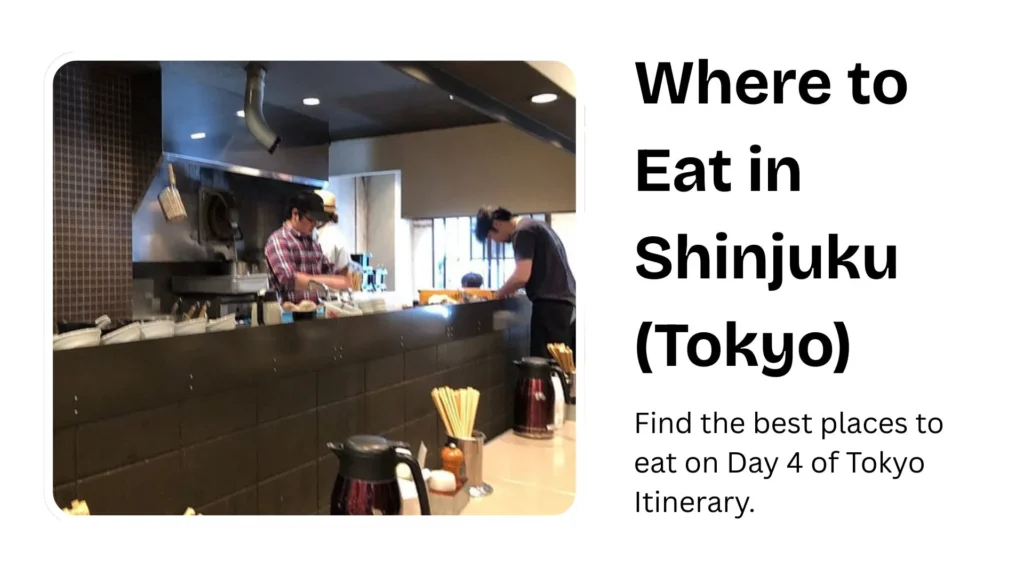
A hidden gem recommended by a local friend, Tatsukichi serves up Kushiage — skewers of meat, seafood, and veggies, lightly deep-fried and served omakase-style.
The chef chooses the skewers and tells you what sauce to dip them in.
Expect around 10–12 skewers + drinks for approx ¥5,000–6,000 per person.
The food is crispy, flavorful, and surprisingly light — not overly greasy.
This spot gets packed, so come early or be ready to wait.
Craving ramen with a twist? Try Tsukemen Gonokami, a cozy spot famous for its rich, flavorful tsukemen — thick noodles served separately with a dipping broth.
What makes it special?
- The broth is super creamy and seafood-based, giving it a deep, umami punch
- Portions are generous and satisfying
- It’s popular with both locals and tourists, so arrive early or expect a short wait
Day 5: Tuna Auctions, Digital Art & Historic Sights
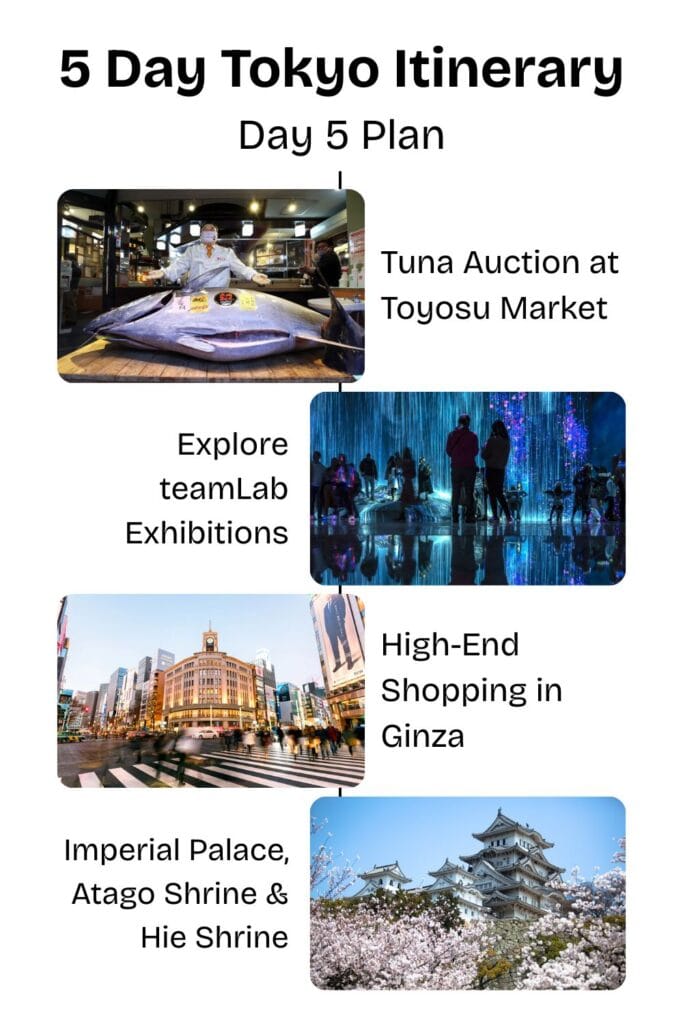
Your final day in Tokyo is all about contrasts—starting with the high-energy action of a fish auction at dawn and ending with serene shrines and elegant shopping streets. Let’s dive into a day packed with authentic Tokyo moments.
1. Early Morning (Around 5:00 AM): Witness the Tuna Auction at Toyosu Market
Begin your day early, and proceed to Toyosu Fish Market, Tokyo’s largest wholesale seafood market. The main attraction here is the legendary tuna auction, where bluefin tunas of monstrous size are auctioned for astronomically high prices (the record-bid was $800,000!).
How to watch the auction:
- Public viewing gallery: Free entry, no ticket needed.
- Closer view: Requires a lottery win in advance (apply here).
- Auction runs from around 5:30 to 6:30 AM, so plan to arrive early.
After the show, reward yourself with a sushi breakfast. Try Sushi Dai or Sushi Daiwa—but be prepared to queue. Don’t want to wait? Pick a smaller stall with fewer people. You’ll still enjoy fresh, top-quality sushi.
Note: The market is closed on Sundays and national holidays. Check the schedule before you go.
Optional detour: If you want an old-school market vibe, visit the nearby Tsukiji Outer Market for more sushi stalls and snacks.
2. Late Morning: Explore teamLab Exhibitions (Planets or Borderless)
Next, head over to a teamLab exhibition—Japan’s famous immersive digital art shows. These are interactive, mind-bending experiences that blend lights, mirrors, motion, and sound.
- teamLab Planets: Walk through water, float in digital art. Super interactive.
- teamLab Borderless: Visually stunning and more iconic. Recently reopened at Azabudai Hills.
Important tips:
- Buy tickets in advance (via Klook or the official website).
- Choose morning slots to avoid crowds.
- Avoid weekends and holidays for a better experience.
3. Afternoon: High-End Shopping in Ginza
From digital art to designer boutiques—welcome to Ginza, Tokyo’s luxury shopping district. Here, you’ll find:
- The flagship stores of Uniqlo and MUJI
- Trendy cafes and department stores
- The famous MUJI Hotel
On weekends and holidays, the main street turns pedestrian-only from 12 PM to 5 PM—perfect for strolling and people-watching.
4. Late Afternoon: Explore Tokyo Station’s Underground Streets
Don’t leave Tokyo without exploring Tokyo Station’s basement, a hidden paradise of shopping and food:
- Ramen Street – 8 top ramen shops including the famous Rokurinsha (try their Tsukemen!)
- Character Street – Shop for Pokémon, Ghibli, Hello Kitty, and more
- Omiyage (gift) street – Great for souvenirs before flying home
Tip: Most stores close by 8:30 PM, so come before dinner.
5. Evening: Imperial Palace, Atago Shrine & Hie Shrine
Wrap up your Tokyo trip with a dose of culture and history.
Imperial Palace: Stroll the gardens of Japan’s imperial family residence. It’s peaceful and beautifully kept.
Atago Shrine: Climb the “Stairway to Success”—86 stone steps symbolizing the path to personal growth and professional success.
Hie Shrine: A peaceful, lesser-known Shinto shrine in Akasaka. If you visit around New Year, you’ll see locals doing Hatsumode, the year’s first prayer.
Where to Eat on Day 5
Rokurinsha (Tokyo Station): The ultimate tsukemen spot. Go during off-hours to avoid the long line.
Onigiriya Marutoyo (Tsukiji Market): Classic Japanese rice balls with various fillings—cheap and delicious!
Ginza Bairin: Famous for juicy tonkatsu (breaded pork cutlet).
Ningyocho Imahan (Ginza): A great place to try wagyu beef or sukiyaki.
Pro Tip for Travelers:
If you’re flying out of Tokyo via Haneda Airport, you can grab your last bowl of Rokurinsha there too—yes, they have an airport branch!
More Fun Things to Do in Tokyo (If You Have Extra Time!)
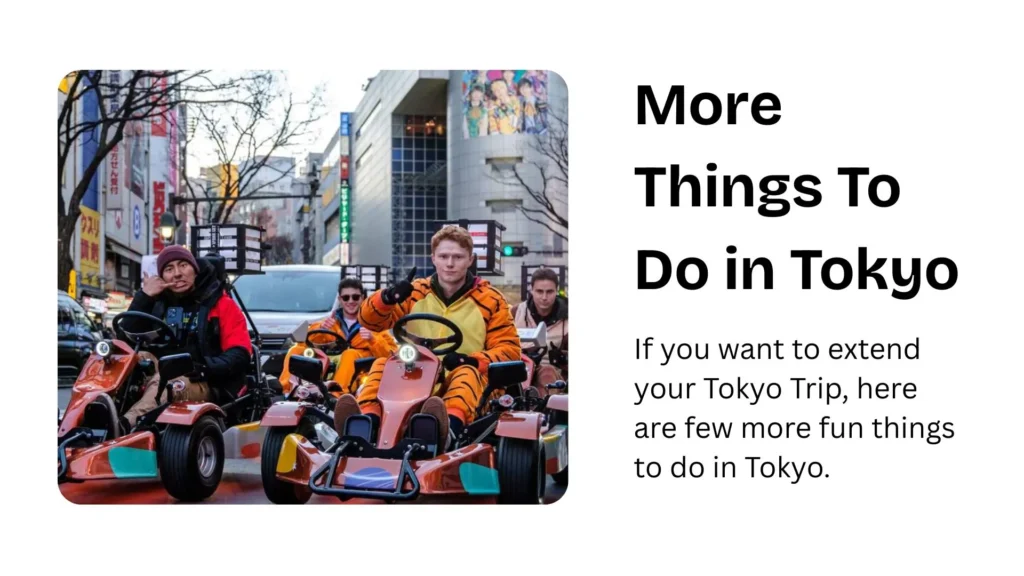
Still have time left in Tokyo and wondering what else to explore? Here are some unique and exciting experiences to add to your itinerary:
1. Go-Kart Through Tokyo’s Streets (Costumes Included!)
Driving a go-kart in Tokyo, dressed up as your favorite character, is as fun as it sounds—but it takes a bit of planning!
- You must be 18+ and have a valid international driver’s permit.
- Book your tour online in advance—some require 2 days to a month’s notice.
- At the shop, you’ll get a quick lesson, a locker for your stuff, and a costume to wear.
- The guide sets the route and pace, so just follow along and enjoy the ride!
It’s a fun and memorable way to see the city—and yes, you’ll turn a lot of heads!
2. Take a Sunset Cruise in Tokyo Bay
Hop on a Symphony Cruise for a 2-hour sail around Tokyo Bay. It departs from Hinode Pier and includes a luxurious 5-course meal onboard.
Whether you’re looking for a romantic date or a relaxing afternoon with city views, this cruise is a perfect escape from the urban buzz.
3. Join a Ramen Tasting Tour
Love ramen? Then this is a must. Join a Tokyo Ramen Tour and try up to six different styles of ramen—from miso to soy, chicken to pork broth.
- Perfect for foodies who want to explore beyond just tonkotsu.
- Tasting portions are served, but come hungry—you’ll leave full and happy!
This is one of those food tours you’ll remember forever.
4. Visit the Studio Ghibli Museum
If you’re a fan of Spirited Away, My Neighbor Totoro, or Howl’s Moving Castle, the Studio Ghibli Museum in Mitaka is a dream come true.
- See original sketches, watch exclusive short films, and shop for rare Ghibli merch.
- It’s a small museum—2 hours is plenty.
- Good news: You can now book tickets online in English!
5. See the Lucky Cats at Gotokuji Temple
Just a short ride from Shinjuku is Gotokuji, a peaceful neighborhood that’s home to the Lucky Cat Temple—aka the birthplace of the famous Maneki Neko figurine.
Expect shelves and courtyards full of these white cat statues. It’s quirky, photogenic, and has a calm vibe that’s perfect for a mid-day escape.
6. Step Into a Real-Life Anime at Hotel Gajoen
This isn’t just a hotel—it’s art. Hotel Gajoen Tokyo is nicknamed the “Museum Hotel” and is said to have inspired scenes from Spirited Away.
Even if you’re not staying there, you can visit and walk through its beautifully designed hallways, traditional rooms, and exhibitions. It’s like stepping into a painting.

